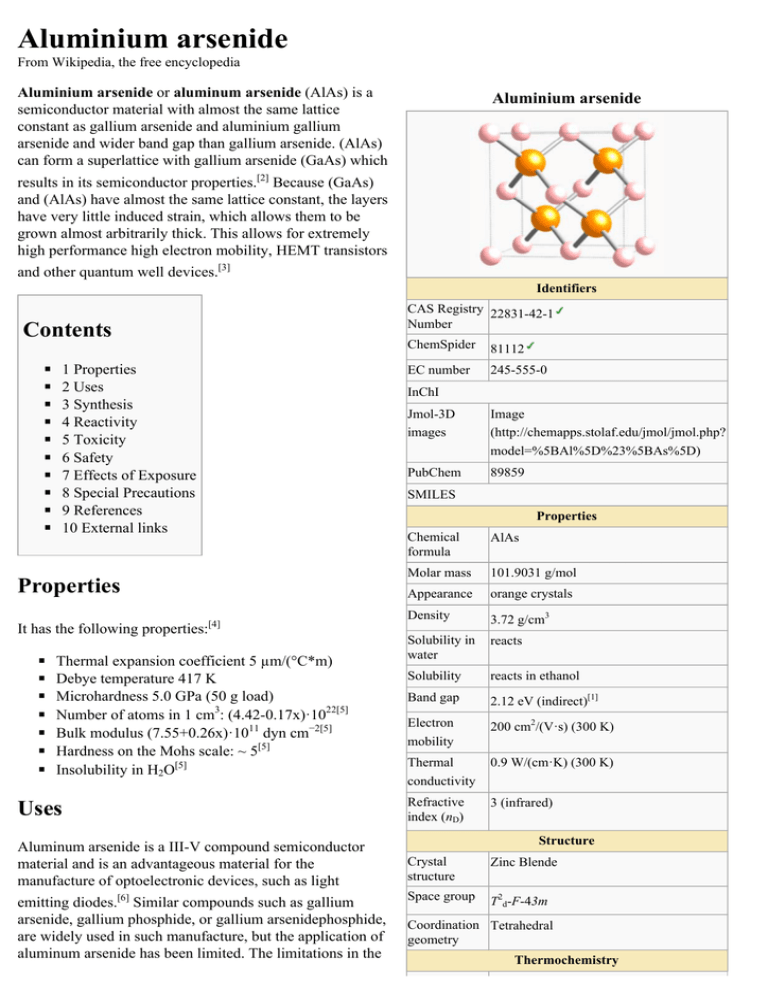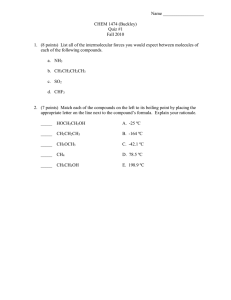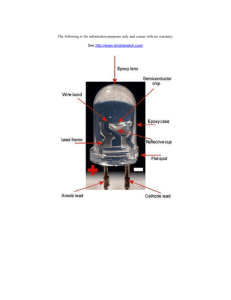Aluminium arsenide
advertisement

Aluminium arsenide From Wikipedia, the free encyclopedia Aluminium arsenide or aluminum arsenide (AlAs) is a semiconductor material with almost the same lattice constant as gallium arsenide and aluminium gallium arsenide and wider band gap than gallium arsenide. (AlAs) can form a superlattice with gallium arsenide (GaAs) which Aluminium arsenide results in its semiconductor properties.[2] Because (GaAs) and (AlAs) have almost the same lattice constant, the layers have very little induced strain, which allows them to be grown almost arbitrarily thick. This allows for extremely high performance high electron mobility, HEMT transistors and other quantum well devices.[3] Identifiers CAS Registry 22831-42-1 Number Contents ◾ ◾ ◾ ◾ ◾ ◾ ◾ ◾ ◾ ◾ 1 Properties 2 Uses 3 Synthesis 4 Reactivity 5 Toxicity 6 Safety 7 Effects of Exposure 8 Special Precautions 9 References 10 External links ◾ ◾ ◾ ◾ ◾ ◾ ◾ 81112 EC number 245-555-0 InChI Jmol-3D images Image (http://chemapps.stolaf.edu/jmol/jmol.php? model=%5BAl%5D%23%5BAs%5D) PubChem 89859 SMILES Properties Properties It has the following properties: ChemSpider [4] Thermal expansion coefficient 5 µm/(°C*m) Debye temperature 417 K Microhardness 5.0 GPa (50 g load) Number of atoms in 1 cm3: (4.42-0.17x)·1022[5] Bulk modulus (7.55+0.26x)·1011 dyn cm−2[5] Hardness on the Mohs scale: ~ 5[5] Insolubility in H2O[5] Uses Aluminum arsenide is a III-V compound semiconductor material and is an advantageous material for the manufacture of optoelectronic devices, such as light emitting diodes.[6] Similar compounds such as gallium arsenide, gallium phosphide, or gallium arsenidephosphide, are widely used in such manufacture, but the application of aluminum arsenide has been limited. The limitations in the Chemical formula AlAs Molar mass 101.9031 g/mol Appearance orange crystals Density 3.72 g/cm3 Solubility in water reacts Solubility reacts in ethanol Band gap 2.12 eV (indirect)[1] Electron mobility 200 cm2/(V·s) (300 K) Thermal conductivity 0.9 W/(cm·K) (300 K) Refractive index (nD) 3 (infrared) Structure Crystal structure Zinc Blende Space group T2d-F-43m Coordination Tetrahedral geometry Thermochemistry application of aluminum arsenide are caused by difficulties in the preparation of high-purity single crystals, the reactivity of aluminum and the instability of crystals when [5] exposed to moisture found in ambient air. Aluminum arsenide can be prepared using well-known methods, such as liquid and vapor-phase epitaxy techniques or melt-growth techniques. However, aluminum arsenide crystals prepared by these methods are generally unstable and generate arsine (AsH3) when exposed to moist air.[5] Aluminum arsenide has also been described in the [7] production of some solar cells. Synthesis Std molar 60.3 J/mol K o entropy (S 298) Std enthalpy of formation -116.3 kJ/mol (ΔfHo298) Related compounds Related Aluminium gallium arsenide, Aluminium semiconductor indium arsenide, Aluminium antimonide, materials Boron arsenide Except where otherwise noted, data are given for materials in their standard state (at 25 °C [77 °F], 100 kPa). verify (what is: / ?) Infobox references Little work has been reported on the preparation of aluminum arsenide, mainly because of the practical difficulties involved. Preparation from the melt is difficult because of the high melting point of the compound (about 1,700°C) and of the extreme reactivity of aluminum at this temperature. A few workers have prepared small crystals from the melt, and polycrystalline ingots have also been produced. The best of this material has an impurity carrier density of the order of 1019/cm3 and is p-type.[8] Reactivity Aluminum arsenide is a stable compound however acid, acid fumes and moisture should be avoided. Hazardous polymerization will not occur. Decomposition of aluminum arsenide produces hazardous arsine gas and arsenic fumes.[5] Toxicity The chemical, physical and toxicological properties of aluminum arsenide have not been thoroughly investigated and recorded. Aluminum compounds have many commercial uses and are commonly found in industry. Many of these materials are active chemically and thus exhibit dangerous toxic and reactive properties.[5] Safety ◾ ◾ ◾ ◾ ◾ ◾ ◾ Non-flammable[5] Route(s) of Entry: Inhalation: Yes; Skin: No; Eyes: No; Ingestion: Yes[5] Target Organs: May affect the liver, kidneys, skin, lungs and lymphatic system.[5] Carcinogenicity: NTP: Yes; IARC Monographs: Yes; OSHA Regulated: Yes.[5] Recommended Exposure Limits: No toxicity data recorded.[5] Medical Conditions Generally Aggravated by Exposure: Pre-existing respiratory and disorders.[5] When heated to decomposition, aluminum arsenide may emit toxic fumes of arsenic oxide and arsine.[5] Effects of Exposure Aluminum compounds have many commercial uses and are commonly found in industry. Many of these materials are active chemically and thus exhibit dangerous toxic and reactive properties. The chemical, physical and toxicological properties of aluminum arsenide have not been thoroughly investigated and recorded, however there are some known chronic and acute symptoms based on chemical delivery. Inhalation of Aluminum arsenide may cause acute irritation to the respiratory system. It may also cause chronic arsenic poisoning, ulceration of the nasal septum, liver damage and cancer/diseases of the blood, kidneys and nervous system. Aluminum arsenide is poisonous if ingested and may cause gastrointestinal and skin effects and acute arsenic poisoning. Chronic implications from ingestion include arsenic poisoning, gastrointestinal disturbances, liver damage, and cancer/disease of the blood, kidneys and nervous system. Aluminum may be implicated in Alzheimers. If applied to the skin aluminum arsenide may cause acute irritation but there are no chronic health effects recorded.[9] Special Precautions Precautions to be taken in handling and storage: Store in a cool, dry place in tightly sealed containers. Ensure there is good ventilation. Open and handle container with care. Do not store together with acids. Keep container tightly sealed.[5] References 1. "AlxGa1-xAs" (http://www.ioffe.ru/SVA/NSM/Semicond/AlGaAs/index.html). Ioffe Database. Sankt-Peterburg: FTI im. A. F. Ioffe, RAN. 2. Guo, L. Structural, Energetic, and Electronic Properties of Hydrogenated Aluminum Arsenide Clusters. Journal of Nanoparticle Research. Vol. 13 Issue 5 pg. 2029-2039. 2011. 3. S. Adachi, GaAs and Related Materials: Bulk Semiconducting and Superlattice Properties. (World Scientific, Singapore, 1994) 4. Berger, L. I. (1996). Semiconductor Materials (http://books.google.com/books?id=Ty5Ymlg_Mh0C&pg=PA125). CRC Press. p. 125. ISBN 978-0-8493-8912-2. 5. Dierks, S.. "Aluminum Arsenide - MATERIAL SAFETY DATA." The Fitzgerald Group - MIT. MIT, 1994. Web. <http://sauvignon.mit.edu/fitz/safety/aluminumarsenide.pdf>. 6. Minden, H. T. Some Optical Properties of Aluminum Arsenide. Applied Physics Letters. Vol. 17, Issue 9. pg. 358-360. 1970. 7. Fraas, L.M. (1978). U.S. Patent No. 864, 300. Washington, DC: U.S. Patent and Trademark Office. 8. Willardson, R., and Goering, H. (eds.), Compound Semiconductors, 1, 184 (Reinhold Pub. Corp., New York, 1962). 9. Sax. Dangerous Properties of Industrial Materials. Eighth edition. 2005. External links Retrieved from "https://en.wikipedia.org/w/index.php?title=Aluminium_arsenide&oldid=641228056" Categories: Arsenides Aluminium compounds Semiconductor materials III-V compounds ◾ This page was last modified on 6 January 2015, at 11:33. ◾ Text is available under the Creative Commons Attribution-ShareAlike License; additional terms may apply. By using this site, you agree to the Terms of Use and Privacy Policy. Wikipedia® is a registered trademark of the Wikimedia Foundation, Inc., a non-profit organization.






